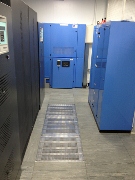With the increasing adoption of technology across the NHS to run electronic systems such as PACS and RIS, pressure is falling on IT managers to protect against failures and to ensure patient information is secure.
But another pressing issue is the demand by central government for a significant reduction in carbon emissions across the public sector, but in particular throughout the NHS, which has the biggest carbon footprint of all UK organisations.
Most data centres are built externally, where enough space can be created to house all the cabinets and associated technology such as air conditioning systems
This has led to a new wave of data centres cropping up at hospitals up and down the country, replacing disparate cupboards and small rooms which traditionally housed servers and other critical technology.
Explaining the change of direction, Chris Wellfair, director of Secure I.T Environments, told BBH : “In a lot of hospitals, you will find small rooms at the end of corridors where they are storing a server. The trouble is each of these separate areas will need cooling technology and this air conditioning has a very big carbon footprint. But hospitals are stuck because they often do not have room for larger data centres.”
But, recognising the impact such a centre could have on helping to reduce carbon emissions, hospital trusts have recently had a change of mind.
Some are outsourcing to off-site data centres through a third party supplier, but many have chosen to build new data centres, a move that could see them cut energy bills by around £20,000 a year. Secure I.T Environments has worked with more than a dozen hospital organisations over recent years, creating data centres in old mortuaries and even on the roof of ward blocks.
The NHS is now recognising that to run these systems efficiently, and to protect patient information, they have to start considering high security data centres that will provide protection against external threats, as a very real need
“Most data centres are built externally, where enough space can be created to house all the cabinets and associated technology such as air conditioning systems,” said Wellfair. “At Guy’s & St Thomas’ Hospital, we created a facility in an underground car park in an area that was formerly used a cycle store, which meant security had to be extremely tight due to the high accessibility to members of the public.”
The Guy’s & St Thomas’ scheme also posed additional problems due to the close proximity of the estate to the River Thames and the risk of flooding.

The data centre was built to be highly secure and to mitigate flood risk from the nearby River Thames
The resulting 97sq m modular building took 20 weeks to construct and houses 20 19-inch computer cabinets. Built to an MOD LPS1175 security rating, a cage was installed around the outside of the centre and the external condenser compound for added security. The building also includes heavy-duty raised access flooring, HV & LV energy efficient power infrastructure, energy-efficient air conditioning, full structured cabling, an energy-efficient N+1 UPS system, fire suppression and VESDA early warning detection technology, 19” cabinets with cold aisle containment, access control, CCTV, high-security external wall mesh, and an intelligent building management system. To address the risk of flooding, the company developed a tanking system incorporating a membrane and concrete flood defence barrier around the external perimeter of the room.
Speaking about the potential for energy efficiency savings through the creation of data centres, Wellfair said: “The reason for the high cost of energy centres in terms of energy use is the hardware that’s being driven and the air conditioning and back-up systems they need for support.
In the past IT departments have always been the last to get any investment, but they are one of the key departments within a hospital that can help to drive carbon reduction
”However, modern hospitals are full of very large machinery and technology that is reliant on, and driven by, IT systems. For example, picture archiving and communications systems (PACS) are totally reliant on IT and hospitals cannot afford to have any downtime whatsoever. The NHS is now recognising that to run these systems efficiently, and to protect patient information, they have to start considering high security data centres that will provide protection against external threats, as a very real need.
“In the past IT departments have always been the last to get any investment, but they are one of the key departments within a hospital that can help to drive carbon reduction.”
Energy consumption, and associated costs, are mainly reduced through more energy-efficient lighting, air conditioning and uninterruptable power requirements, though the potential cost savings will depend on the type of infrastructure installed.
Wellfair concluded: “We have already worked with a number of trusts and each will have different requirements, but they all recognise how energy efficient data centres can help to drive a significant reduction in carbon emissions and also cut costs.”




